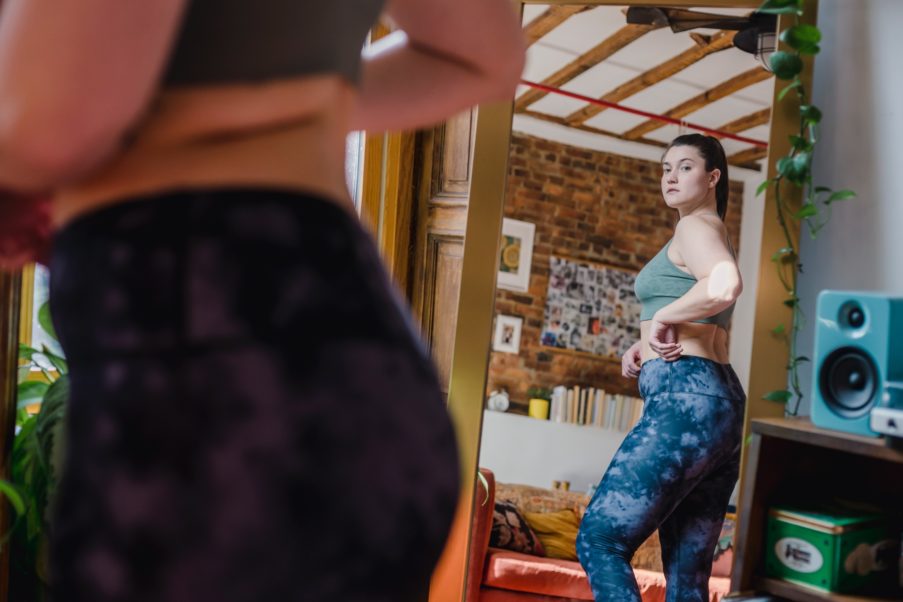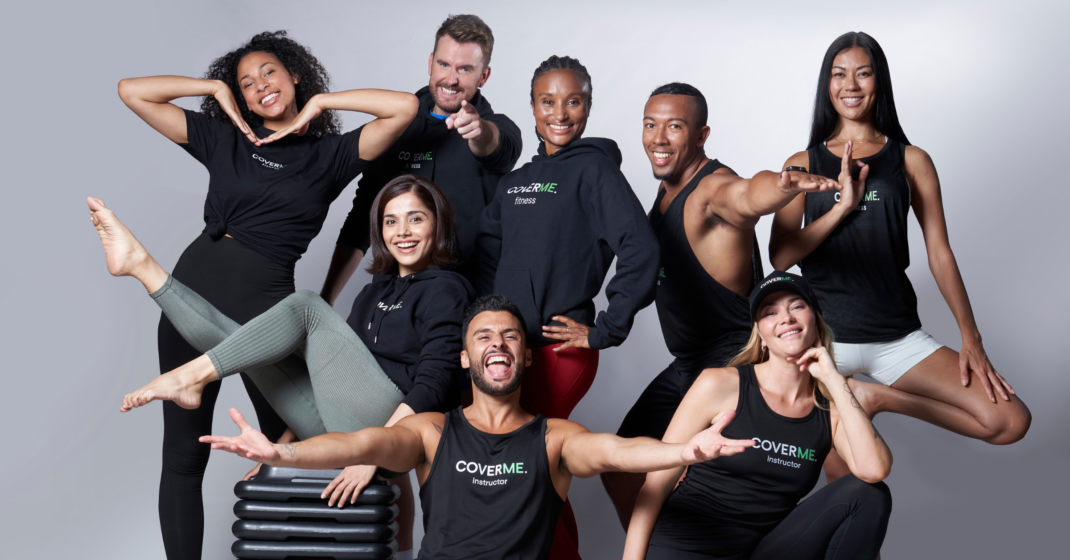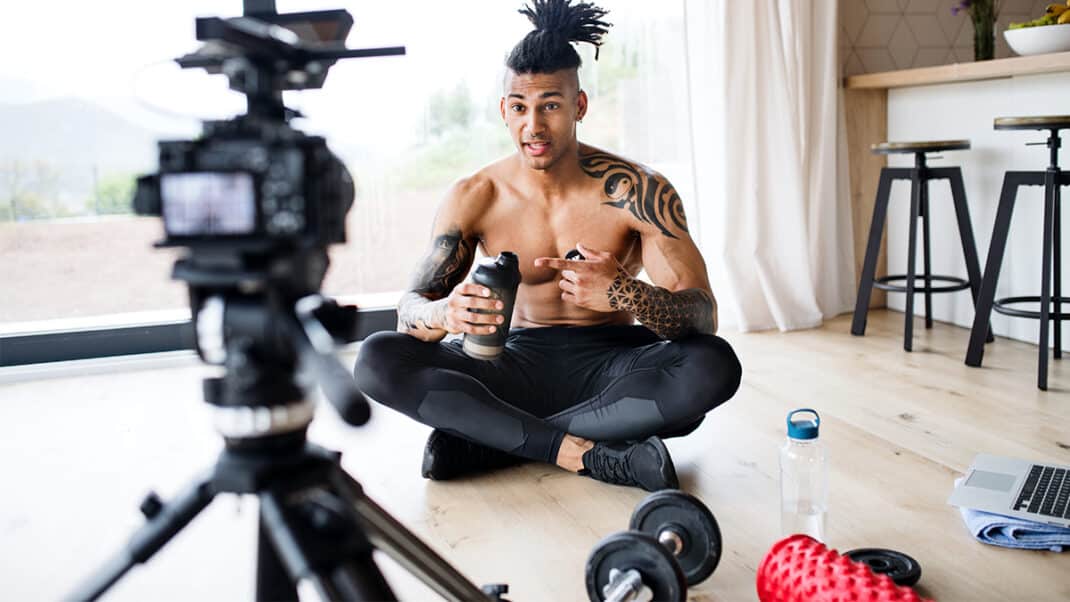Body Image and the Fitness Industry
A look at why our industry does indeed have a body image problem—and what we can do about it, starting now.

Fitness professionals often bemoan how clients can be too appearance-oriented in their fitness pursuits, harboring negative body image and/or unrealistic expectations around shaping the “perfect” physique.
What about us?
How do personal trainers and fitness instructors fare in the face of body insecurities? A lot of us put pressure on ourselves—and each other—to look a certain way. Individually, fitness pros vary widely in where they fall on the body image spectrum, which extends from abject dissatisfaction to healthy self-perception. But even if our own perspective falls within the “contented range,” we must recognize that, as an industry, we have a problem. There’s tacit, and sometimes blatant, body shaming. There’s pressure to appear lean, muscular and athletic as a way to prove our professional worth and knowledge. And there’s the predicament of trying to help clients feel good about their bodies when many of us wrestle with our own woes.
Body image issues in the fitness industry are nothing new. But the need for a more positive philosophy and more diverse perceptions of beauty is especially relevant right now. With rising competition from fitness technologies, social media stars who plug fitness, TV trainers and an increasingly crowded marketplace within our own communities, a nice body can (and should) only get you so far in this industry. We need to emphasize qualifications more than we already do. And we certainly can’t afford to discourage people from exercising because of worn-out stereotypes about how a fit body is “supposed” to look. Our strength and longevity as an industry rely in part on greater acceptance of body diversity among our clients and participants. But to foster this open-mindedness, we must first extend acceptance to ourselves and to each other. Let’s break open this age-old problem and start working on new solutions.
“You’re a Trainer? Let’s See Your Six-Pack!”
Most fitness pros say a fit body doesn’t have to be thin and noticeably muscular. But the image that the industry typically showcases as “fit” in its ads, marketing, social posts and education is still pretty clichéd—a youthful, hyperfit male or female physique that even many fitness pros haven’t been able to (or cared to) attain.
“The fitness industry does a wonderful job of conveying the message that an active, healthy lifestyle is beneficial for all. However, the images that often accompany this message are those of fitness models with low body fat and [similar-looking] proportions,” says Robin M. Gillespie of Transformation Fitness, an NASM-certified trainer in Philadelphia. Fitness ads are rife with unrealistic “fit bodies,” observes Patricia Friberg, MPS, owner of PatriciaFriberg.com, star of numerous workout DVDs and group fitness manager at Equinox in Westlake Village, California. “These images become the industry standard,” she says.
As a result, the general population mostly expects fitness pros to look really fit, too. But what does that even mean? And is it a fair expectation?
Presumably, a fitness pro’s physique is his or her calling card. When you live a healthy lifestyle, your body naturally reflects that. But here lies a conundrum: It’s quite possible to walk the walk of an active lifestyle every day and still look less lean, less muscular and less athletic than someone with an amazing body whose self-care routine is terrible. A trainer with a few pounds to lose might be infinitely more qualified than his or her stereotypically hot-bodied colleague. Just look at Instagram to see which types of “fitness experts” typically garner the most accolades.
“When you have fitness experts who hold no certifications or have no education but are considered experts solely based on the way they look, it makes it difficult for those of us who do have certifications and pursue continuing education,” says Christine DiFilippis, owner of Pop Fit Studio and creator of Red Hot Dance Fitness in Philadelphia.
It’s pretty obvious that a great-looking body doesn’t guarantee skills and qualifications—so why do people think otherwise? Well, some folks are just uninformed. But, thanks to today’s marketing campaigns, they’re not entirely to blame; many aspects of the industry perpetuate this myth. We need a messaging makeover.
For example, everyone knows (don’t they?) that fitness is largely about function: how well your body works and what it can do. Are we selling this concept strongly enough? “In the last decade or so, there seems to have been a shift toward health and performance,” says James S. Fell, MBA, CSCS, owner of bodyforwife.com and author of Lose It Right (Penguin Random House 2014). “Although I see us moving in a better direction, vanity still plays a significant role in this industry, and that can create body image issues.”
Most people naturally evaluate fitness by what they can clearly observe and describe. “Attributes like strength, VO2, coordination, reactivity, speed and power are all quantifiable and can be considered markers of good fitness. But they are not visible,” says Pete McCall, MS, a San Diego–based personal trainer and fitness educator and host of the All About Fitness podcast. “Having a lean, muscular body is often the only sign of ‘fitness’ that people understand; therefore, it becomes the criterion by which people often judge whether or not someone is in good shape.”
And so we arrive at the notion that a “fit-looking” body is a marker of professional competence. Have you ever received a compliment for “looking like” a trainer or instructor . . . or been criticized for not having that look? Both scenarios speak volumes about body image in our industry. Says Fell, “I still hear a lot of chatter in the industry about the need to ‘look the part.’ It’s a powerful marketing tool for trainers. When it comes to those who make the most money and have the most popularity via TV and best-selling books, it is still absolutely required to have that stereotypical fit-looking body.”
There’s nothing wrong with striving to look good, of course, but fitness-for-appearance should not supplant fitness-for-function. Amplifying the latter message could lessen unnecessary pressure on fitness pros and encourage a better exercise experience for clients. “It is our job to educate existing and potential clients on what true fitness is: having the [physical] ability to enjoy life and do any activity they want at a moment’s notice,” says McCall. Expounding a broader, kinder definition of a fit body to the general population might even entice more people to begin a workout program.
“We’re so focused on ‘fitness’ looking like one body type. If you don’t fit that mold, you’re made to feel like you don’t belong in the industry,” says Carrie Myers, owner of CarrieMichele Fitness and a master-level transformational coach in New Hampshire. Besides that, bodies change. Injury, surgery, pregnancy and/or personal setbacks can derail your workouts, altering the way your body looks, even though your qualifications remain rock-solid.
All this leaves fitness pros—men and women representing a range of body types—with a lot of body image baggage to unpack (or leave behind).
See also: Body Image and Fitspo: The Male Perspective
Pressures From the Outside—and From Within
The pressure for fitness pros to look a certain way stems from multiple areas: traditional industry marketing, television shows, social media commentary, competition with colleagues and client/manager expectations, to name a few. Even strangers seem to have an opinion. “Recently. someone I’d just met told me that I didn’t look like I would be a personal trainer,” says Myers, “because, as this person put it, ‘They’re usually a lot skinnier and more fit.’” At the time, Myers was recovering from several surgeries. “I thought I was doing pretty well to be back to the level I was at!” she says.
“On the flip side,” Myers continues, “several years ago, when I was very fit, I was told by a gym manager that he was surprised I was so successful with women clients. When I asked why, his response was, ‘Well, look at you. I’m surprised women would want to work with you, because you must be intimidating to them.’”
Gillespie has also received comments on her physical appearance while on the job. They spurred her to join Black Girl Pilates, a group that seeks to provide better representation for Black/Afro Latina women in the mind-body space. “When I first started teaching, people thought it was okay to make comments about my curves,” she says. “And sometimes a co-worker would comment on my butt, saying it was large, when in fact it is in proportion with my build.”
Many fitness pros also burden themselves with expectations. “I used to feel immense pressure to look a certain way,” says DiFilippis. “I thought that in order to be a fitness professional, you had to look lean but muscular, with six-pack abs.” Her struggle with body image in the fitness industry eventually led to an eating disorder and a hiatus from teaching group exercise (read more of her story in the sidebar “We’re All in This Together”).
Myers can relate, having struggled with anorexia and what she calls “an anorexic mindset” about 25 years ago. “I had to leave the industry for a while so that I could heal,” she says. “I just couldn’t get beyond where I was with the eating disorder [while I was] being continually bombarded with images of perfection and feeling like I didn’t and never would measure up.” She has since written a book called Squeezing Your Size 14 Self into a Size 6 World: A Real Woman’s Guide to Food, Fitness and Self-Acceptance (Champion Press 2004).
Research from Norway, published in the Journal of Eating Disorders, suggests there may be a high prevalence of disordered eating among group fitness instructors (Bratland-Sanda, Nilsson & Sundgot-Borgen 2015). Of the 837 subjects (152 men, 685 women) surveyed in the study, 22% of the male instructors and 59% of the female instructors were classified with disordered eating. This is a concern, not only because of the impact on instructors’ physical and mental health, but also because instructors are held up as role models of, and authorities on, health—in gyms, in their communities and even on social media.
See also: Fit Pros Face Body Image Pressures from Both Directions
Social Media Isn’t Helping
What about social media’s role in all of this? Not surprisingly, it contributes to body image pressure. “I gained almost 20 pounds a few years ago due to injury and was reluctant to post any photos on social media,” says Fell. “I didn’t start posting photos again until I lost the weight.” Myers says she’d like to market her fitness business using Facebook Live but is reluctant. “I’m not ready to deal with the jerks who might criticize my body,” she says.
Unfortunately, DiFilippis knows firsthand about trolls. “I often get comments on my Instagram or YouTube videos about the way I look,” she says. “I was very active on Periscope, and the comments about my weight showed up daily. Although I had hundreds of people liking a livestream, I’d have at least one person per day tell me I shouldn’t be ‘an expert,’ because I wasn’t fit enough.”
Research confirms that social media isn’t helping much to promote body diversity and positivity, partly because the fitness message is often reduced to body-conscious pics and objectifying exercise demos. In one study (Carrotte, Prichard & Lim 2017), Australian researchers conducted a content analysis of social media posts tagged with #fitspo (short for “fitness inspiration”) on Instagram, Facebook, Twitter and Tumblr. Among the 415 images analyzed (mostly taken from Instagram), posts of women were significantly more likely to be sexualized, show the full body and emphasize the buttocks; posts of men were more likely to have the face visible in addition to the body. In terms of overall appearance, the women in the #fitspo content streams were typically “thin and toned,” while the men were typically “muscular or hypermuscular” (Carrotte, Prichard & Lim 2017).
An online survey conducted out of California State University, Monterey, showed that 63% of male and female respondents (most of whom exercised weekly) agreed that the fitness industry on social media implies you have to look a certain way (Norton 2017). It’s not a stretch to imagine that social media might exacerbate body image concerns for just about everybody. In fact, a meta-analysis—where researchers analyzed a group of correlational, experiential and longitudinal studies on body image and social media—revealed that spending more time on social media correlated with negative body image, including higher levels of body dissatisfaction, drive for thinness and appearance comparisons (Fardouly & Vartanian 2016). This pattern was similar for men and women.
See also: Social Media Contributes to Body Image Pressure
The Change Starts With Us
Fitness instructors and personal trainers are influential not only as visual role models but also by what we communicate to participants and clients about body image and fitness. “As leaders in the industry,” says Friberg, “we can help integrate positive body image and a healthy mindset. Establishing fitness goals and working hard are important, but so is practicing self-acceptance and compassion.”
It’s likely that the industry’s tacit and overt beliefs about body image transfer to clients and participants (adding to whatever hang-ups they already possess). We have the choice to contribute to a fitness-related body image culture that is either positive and accepting or negative and shaming. “We need to be aware of the messages we are sending, both verbally and nonverbally, in our classes, in our posts, with our everyday lives,” says Friberg.
Watching our body language. By commenting negatively on body image or using words like “get ripped,” “destroy fat” or “slim down problem areas,” we encourage clients to view us, one another and themselves in a critical way. On the flip side, by eating well and staying active, we demonstrate optimal health and fitness, free from the angst of disordered eating and body insecurity. Even how we refer to our colleagues or our own bodies in front of clients can have an impact, either good or bad. “We have to be comfortable in our own skins before we can coach clients on how to be comfortable in theirs,” says McCall.
Advocating body diversity in marketing. As fitness professionals and representatives of our industry, we must support and advocate for more diverse male and female body types in marketing, at conferences and in gyms. This applies not only to body size but also to underrepresented body shapes and features based on race, ability and age.
Focusing on function over form. Finally, let’s remember and celebrate that not all fitness clients expect or prefer trainers and instructors with a stereotypical appearance. “[These days,] more people are interested in finding trainers who are a good psychological fit and who actually know what they’re doing and have strong credentials and experience, rather than just choosing the one with the fittest body,” says Fell.
“We can’t all look superfit,” adds Fell “Not only that, but we don’t all want to look like that, and that’s okay.”
When it comes to body image, our industry’s purpose runs much deeper than appearance. Our goal should be to emphasize function while embracing a more realistic variety of body types. The result will be a healthier industry for everyone.
Every Body’s Different (and Clients Prefer That)
In my master’s thesis research, female fitness participants expressed diverging perspectives on body image and the role of the fitness instructor. Some women in the study did prefer a female instructor with a stereotypically fit body, because they found it motivating. Others resisted this look and sought an instructor with a curvier, more athletic build, because they found this more relatable and attainable (Vogel 1998).
“I like to see someone who looks a little more normal as opposed to really, really fit,” said one study participant named Heidi, aged 30. For her, encountering a “really fit” instructor created anxiety about her own fitness level and ability to keep up in class (Vogel 1998).
Signs Our Industry Has a Body Image Problem
Expectations about body image in the fitness industry crop up in different ways for different people. Some fitness pros ruminate about body image quite often (every day or even every hour), perhaps taking extreme measures to alleviate concerns. Others never really give it that much thought.
Many of your fitness colleagues may have experienced one or more of the following situations and felt unnecessary pressure to prove their worth in the industry. Perhaps you have, too. See how many of these statements you can answer yes to, keeping in mind that your industry colleagues may have had the same or very different experiences (why not ask them?). The point isn’t to tally the most or least yes answers. Rather, it’s to shine a light on our diverse perspectives and see how we might inadvertently be perpetuating the industry-wide body image problem we ultimately hope to alleviate. The more we understand each other’s experiences, the better we can unite to support each other and encourage better body diversity.
Have you ever . . .
- had a client or colleague tease or chide you for not having six-pack abs or jacked arms? Or for having thighs that were too big or muscles that were too small?
- severely restricted food, purged or overexercised to control weight?
- been told you were hired at a gym or fitness company because you looked great in spandex?
- been encouraged by a boss to lose weight or gain muscle?
- worn Spanx under workout attire to teach a class?
- compared your physique to the body of a hot “trainer” on Instagram who has a million followers and zero certs?
- taken a selfie at the gym more than 10 times in a row, trying to capture your body at its best angle?
- panicked because you thought you didn’t look fit enough for an upcoming photo or video shoot, conference, or event?
- worried about being ridiculed for how you looked when posting a fitness-related photo or video on social media?
- had difficulty connecting with a deconditioned new client or participant because he or she felt intimidated by how fit you looked?
- received a backhanded compliment from a participant, manager or colleague who was surprised you could be so good at teaching, training or presenting, since your body type didn’t fit the usual mold?
- been personally surprised at the skills of an instructor, trainer or presenter who didn’t have a stereotypical “fit-looking” body?
- scrutinized a body part that you perceived might not look conditioned enough?
- been praised for “looking the part” of a fitness professional?
We’re All in This Together
One instructor shares her story on what it’s like when the pressure to look a certain way in the fitness industry becomes too much.
Meet Christine DiFilippis. As the owner of Pop Fit Studio and creator of Red Hot Dance Fitness in Philadelphia, she’s an accomplished fitness pro and ambassador for the Body Image Movement, a global team of role models promoting positive body image.
Like many fitness pros, DiFilippis grew up watching television workout shows. The instructors were lean and muscular with six-pack abs—a visual that stuck with DiFilippis. Later, it would contribute to her struggle to feel a sense of belonging in the fitness industry.
Here’s her story:
“I spent a great deal of time trying to look like the fitness professionals I saw on TV and in magazines, but I was never thin enough and definitely never had anything close to six-pack abs. I became more restrictive with my diet, trying one diet craze after another: low fat, low carb, counting calories. You name it, I tried it.
“I became obsessed with exercising, even to the point of being hospitalized in my early 20s. I would spend hours at the gym teaching classes, running on the treadmill and lifting weights. Yet I could never reach my goal of attaining that perfect fitness body. A lot of the pressure was from myself, but there were instances when I felt pressure from outside sources, as well, such as managers or other fitness professionals.
“I once went to an event with a fellow fitness instructor, and when we stopped for something to eat, I bought a salad. She was very lean and muscular (the ‘perfect’ image of fitness, in my head) and had a plate full of foods I felt I could never eat. She looked at my plate, pointed to what I perceived as my “unfit” body, and said, ‘You eat that, and you look like this?’ I began to believe I wasn’t a good role model of fitness. Why would anyone look to me or take my classes when a fellow instructor thought I didn’t look fit?
“Once when I was working as a fitness instructor for a large gym chain, the district manager visited our club. She pulled me aside and praised me for teaching great classes. At the time, I had the most attended class on the schedule. But she had concerns because I didn’t ‘look the part.’ She explained that the club was selling an image, sharing ‘before’ and ‘after’ pictures to close the sale when people signed up and to help them on their weight loss journeys so they could have the bodies they’d always wanted.
“This manager compared me with other instructors and said maybe it would be good if I met with a nutritionist and worked with a trainer to meet my goals. I wasn’t trying to lose weight at that time. Having spent a great deal of my life trying to reach unrealistic goals, I had finally accepted my body and begun to love it: curves, imperfections and all. However, my confidence took a hit, and I tried—once again—to attain that perfect body. After a few months of extreme dieting and being miserable, I quit teaching.
“I had become so depressed that I just didn’t want the pressure. I stopped working out completely.
It took 5 years to get back into teaching again. I worked on myself from the inside, rather than focusing on the outside and the scale. Now I have a daily practice to promote a body-confident mindset.”
References
Bratland-Sanda, S., Nilsson, M.P., & Sundgot-Borgen, J. 2015. Disordered eating behavior among group fitness instructors: A health-threatening secret? Journal of Eating Disorders, 3, 22.
Carrotte, E.R., Prichard, I., & Lim, M.S. 2017. “Fitspiration” on social media: A content analysis of gendered images. Journal of Medical Internet Research, 19 (3), e95.
Fardouly, J., & Vartanian, L.R. 2016. Social media and body image concerns: Current research and future directions. Current Opinion in Psychology, 9, 1-5.
Norton, M. 2017. Fitspiration: Social media’s fitness culture and its effects on body image. Capston Projects and Master’s Theses, 138.
Vogel, A.E. 1998. “Body image by association”: Women’s interpretations of aerobics and the role of the fitness instructor. Master’s thesis. Accessed Oct. 25, 2017: open.library.ubc.ca/cIRcle/collections/ubctheses/831/items/1.0077313.
Amanda Vogel, MA
Amanda Vogel, MA, is a fitness professional and the owner of Active Voice, a writing, editing and consulting service for fitness professionals. She writes for IDEA, Health, Prevention, and Self, and has co-authored books on postnatal fitness and yoga. With a master's degree in human kinetics, Amanda has worked in the fitness industry for more than 15 years, including time spent as a program director and vice president for a chain of all-women clubs in Vancouver, British Columbia.






